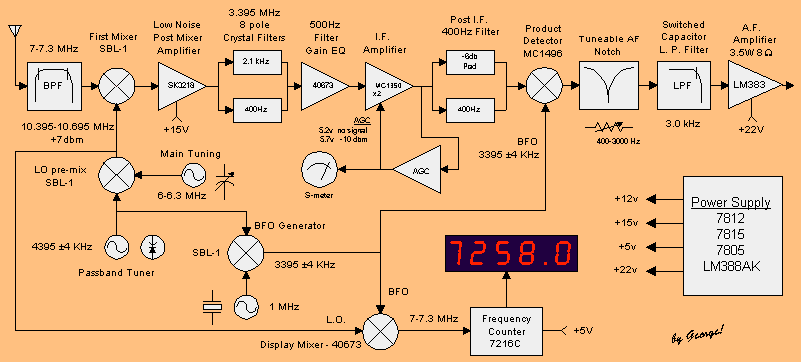![]()
(Proyectos de Receptores)
Note: The following projects were gathered from the internet, therefore the author does not endorse any of the projects, they are on your own risk.
(Nota: Los proyectos siguientes se recogieron de internet, por consiguiente el autor no garantiza ninguno de los proyectos, ellos son bajo su propio riesgo.)
40 meter CW/SSB Receiver
by K9GDT

40 meters is my favorite band. Day or night, winter or summer, high sunspots or low....the band is usually open to some part of the world. So why not build a custom 40m receiver? I thought it would make a great design and construction project.
The K9GDT 40m receiver uses a doubly balanced switching-mode mixer as the front-end converter in a single conversion scheme. This technique ensures optimum front-end overload and IMD performance.
The front panel SELECTIVITY switch allows the selection of a 2.1 kHz or 400 Hz IF bandwidth. Each bandwidth is provided by inserting the appropriate eight-pole crystal filter between the post-mixer amplifier and the IF amplifier. When the 400 Hz position is selected, a second 400 Hz crystal filter is inserted before the product detector to remove broadband noise produced by the IF amplifier.
The PASSBAND tuning control is an operating aid useful in reducing or eliminating interfering signals. It electronically positions crystal filterís response curve around the displayed frequency. This enables the operator to shift that response such that a nearby interfering signal is positioned down on the filterís skirt.
The NOTCH TUNE control varies the center frequency of the AF notch filter. This feature is useful for eliminating interference from CW carriers and is especially useful in the upper portion of the band, which is shared with foreign broadcast services.
The receiver features a ďtunedĒ audio section capable of delivering 3.5 watts to an eight ohm speaker. Frequency response is tailored by active, passive, and switched capacitor filtering circuits.
Other features include external mute control, a transmit monitor mode, selectable AGC time constants, an AGC defeat mode, a CW keyer sidetone input, and a convenient tilt bail located on the receiverís bottom panel.

You can download the
Manual (400K) for this
receiver, viewable with
Acrobat Reader.
The generously illustrated manual includes specifications, circuit descriptions
and a detailed
alignment/calibration procedure. Unfortunately, I never made a complete
schematic diagram for this beast, so none is included in the manual.My
apologies for the My apologies for the
quality of the pictures. They were scanned years ago using a primitive
gray-scale hand scanner. The manual was produced in 1990 using an early version
of Ami Pro. (The receiver project was actually completed in 1985.) ![]() February
28, 1998
February
28, 1998